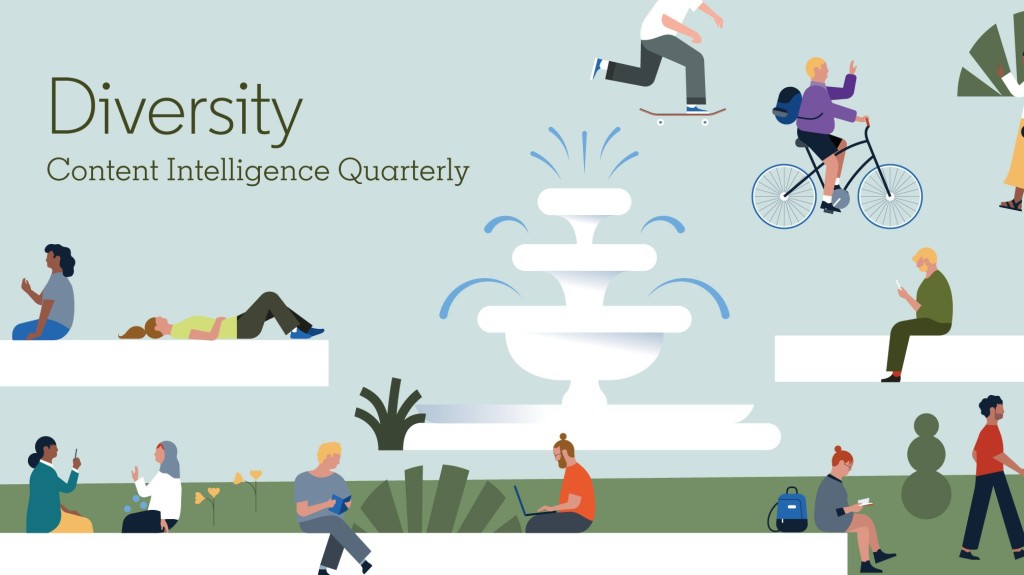The content setting the agenda on diversity
Diversity matters: for both businesses and the brands they depend on. Research such as McKinsey’s annual analysis of diversity and financial performance, increasingly links a diverse company leadership to commercial success and profitability. We know that diversity is critical for building compelling employer brands and accessing business-critical skills. It’s also essential for aligning businesses with the customers they depend on for growth, making the representation of diverse groups in marketing departments, advertising agencies and campaigns a priority for the industry.
However, diversity is also a complex issue, with new challenges emerging and consensus sometimes hard to come by. Attention inevitably focuses on the areas of diversity that are easiest to measure, and this can obscure a lack of progress in other important areas. We know a lot about progress on gender equality – far less about how much is being made on ethnic diversity, or the representation of LGBTQ groups. Analysing the diversity-related content generating the greatest engagement on LinkedIn, as we have done for this latest edition of LinkedIn Content Intelligence, shows the real struggles that businesses still face in making real progress on diversity – and ensuring that the image they present in advertising reflects the reality of how they work.
We’ve taken a detailed look at engagement with diversity-related content on our platform over a six-month period from October 1st 2018 to March 1st 2019. We analysed the diversity-related topics that drive the greatest engagement, and the different issues and priorities that posts around those topics reveal. In this way, we can get a sense of progress in different areas, perceptions of the barriers that still exist and awareness of the value of tackling them.
In this report, you’ll find positive stories and negative ones, robust reports on levels of diversity and areas where data is still lacking. It’s a snapshot of the state of awareness around different issues – and just as importantly, the opinions that are shaping the thinking of leaders and decision-makers.
Who’s engaging with diversity content?
The growing importance of diversity within business strategy and success is reflected in who engages with diversity-related content. LinkedIn insight shows greatest engagement coming from Partners, Directors, VPs and the C-suite, with Partners 4.6x more likely to engage than the average LinkedIn member. Interest peaks among venture capital and private equity firms with PR and Communications and management consulting also strongly represented. This demonstrates the importance of diversity for businesses seeking funding, for those advising on engaging audiences and building stronger brands, and for those charged with finding new sources of growth.
The key diversity themes - ranked
When we rank diversity themes by engagement, it’s clear that gender dominates the conversation. Gender equality is the subject of the greatest number of diversity-related posts – and those posts generate the highest average engagement.
1. Gender diversity: data leads the conversation
Data is more readily available on gender than any other aspect of diversity, and this is reflected in the nature of the most popular content on LinkedIn. Leading studies include research from Accenture on equality and innovation in the workplace; a study of the relationship between gender diversity and business productivity; analysis of how female support networks correlate with greater diversity; and rankings of the most gender-diverse businesses and top female leaders.
Other key themes in the gender equality conversation include International Women’s Day (evidence of the impact that a global awareness campaign can have), the need for male allies in promoting gender equality, and worrying evidence that industries such as technology have lost ground in this area.
Inspirational female leaders are a key trend among influential diversity-related posts, with stories of women in leadership positions making up more than 12% of the top 50 most engaging posts.
2. Ethnic diversity: tales of discrimination set the agenda
Ethnic diversity represents the second most engaged-with issue – and two themes dominate content in this area: shocking revelations about discrimination in recruitment and the workplace, and individual stories of those overcoming it. Content highlighting cases of discrimination include IBM’s apology for using insensitive ethnic labels in a job application menu, CNN’s report on a General Motors plant where offensive racial language and threats had been part of daily life, and research showing that applicants from minority ethnic backgrounds in the UK had to send 80% more applications on average, to get a positive response from an employer.
When positive stories are reported, they stand out – and drive significant engagement. Whether that’s the story of tech investor Priyanka Chopra or reflecting on Japan’s attitudes to race through the rise of tennis star Naomi Osaka.
3. LGBTQ rights: individual stories predominate
Content dealing with LGBTQ rights tends to focus on individual stories and experiences. These include role models such as Beth Ford, the first openly gay woman to lead a Fortune 500 company, Apple’s CEO Tim Cook and Metropolitan Police Chief Cressida Dick. Not all stories are positive, however. Posts that talk about the negative impact that coming out can have on careers, and the difficulties of challenging discrimination in the workplace, are equally prominent.
4. Age diversity: advertising and tech lead the way
Advertising and technology are leading the way in raising awareness of the dangers of sidelining older workers, with posts dealing with the two industries representing five of the top 20 generating greatest engagement. These include reports of a Campaign survey showing that 42% of advertising, marketing, media and PR employees have witnessed ageism towards a colleague – and 32% have experienced ageism themselves. A key theme of age-related diversity pieces is the challenge of balancing the value of older workers with the need to create opportunity for younger ones. While the most popular piece of content in this category takes a positive view (Chip Conley’s TED talk on the benefits of mixing different generations), the second-most popular raises more challenging issues, in Harvard Business Review’s exploration of What Happens to Younger Workers When Older Workers Don’t Retire.
5. Cognitive diversity: celebrating early momentum
Awareness of the business benefits of cognitive diversity has accelerated rapidly in recent years – and the positive tone of the most influential posts in this area reflects as much. Engagement is growing from a relatively low base, with content focuses on raising awareness of the value that ‘differently wired’ people bring to the workplace, including those with autism, ADHD and dyslexia.
6. Diversity in marketing and advertising
If businesses are to realise the benefits of tackling the barriers to diversity, they need a marketing and advertising industry that’s attuned to the value of representing such diversity. Campaign’s coverage of TfL’s plans to break the industry silence on the menopause and Channel 4’s prize of free airtime for ads featuring diverse groups (won this year by Engine’s campaign for the RAF), show how the industry is responding.
The 10 diversity-related posts generating greatest engagement on LinkedIn
1. Promote women because they’re good, not because they’re women
This opinion post generated huge engagement by arguing that the way gender equality initiatives are presented to employees, and the response they generate, is as important as the numbers they achieve when it comes to getting more women into senior roles. It’s a provocative view that addresses challenging issues and potential blockers for diversity initiatives – and generated comments expressing a wide range of views on positive discrimination.
The story of Nidhi Yadav, the woman behind ethnic clothing brand AKS, touches on many different aspects of diversity, including the importance of female entrepreneurs, the challenges of working mothers, and ethnic diversity within the fashion industry.
3. Julie Sweet of Accenture Could See Her Future. So She Quit Her Job.
The New York Times’ interview with Accenture’s North America CEO Julie Sweet acts as both an inspiring career story – and a discussion of the enduring nature of unconscious bias and other barriers to gender equality.
4. Women in the Workplace 2018
McKinsey’s annual survey of the state of gender equality sounded an alarm call that progress towards gender equality at every level of business life has stalled, and more concrete action is needed.
5. What baby boomers can learn from millennials at work – and vice versa
Chip Conley is a hospitality entrepreneur and the author of Wisdom@Work: The Making of a Modern Elder. His influential TED Talk helped to push the issue of age diversity up towards the top of the business conversation.
6. Women in IT Awards 2019 finalists revealed
The announcement of the shortlist for Information Age’s Women in IT Awards is one of three posts in the top 20 that are related to diversity rankings, including Reuters’ diversity and inclusion index, and The Financial Times’ list of the 10 most influential BAME tech leaders in the UK.
7. Recruiting at Netflix – Podcast episode
This discussion with Netflix’s VP of Talent Acquisition Nellie Peshkov explored how an admired brand approaches diversity and inclusion through its recruitment process, and the benefits that it gains in terms of innovation.
8. Elite Law Firm’s All-White Partner Class Stirs Debate on Diversity
This New York Times article explored the limits of diversity at big law firms by analysing recently appointed partners at Paul, Weiss.
9. How do you get from diversity to inclusion? Ask these 4 questions about your meetings
In this TED feature, social psychologist Dolly Chung distinguishes between diversity, which is easily tracked through official statistics, and inclusion, which underpins progress on diversity but is far less visible through data.
10. University launches sports hijab for female Muslim students
The story of how Brunel University tackled a key barrier to religious inclusion in sport, by developing a sports hijab that respects religious beliefs while keeping female athletes far cooler and more comfortable than traditional cotton versions.
Editor's Note: Research findings originally published on Campaign.
Related articles



